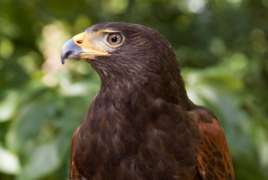Harris Hawk
Harris Hawk
In the case of Harris hawks, birds of a feather don’t only flock together – they hunt and nest together, too. In some regions where they live this species is social, but in most regions, they are observed alone or with just one other hawk. Hawks belong to a group of birds known as raptors, … Continue reading “Harris Hawk”
Parabuteo unicinctus
Carnivore
Mesoamerica, North America, South America
Deserts, Grasslands, Scrublands
This species lives behind the scenes at the World of Wild Theater. You may see one of our Harris hawks in a World of Wild Theater animal presentation.
Photos and Videos
In the case of Harris hawks, birds of a feather don’t only flock together – they hunt and nest together, too. In some regions where they live this species is social, but in most regions, they are observed alone or with just one other hawk.
Hawks belong to a group of birds known as raptors, which are loosely defined by a few physical characteristics. Raptors have keen vision and therefore have large eyes compared to their bodies. There is some variation in the size and shape of their beaks, but they are all curved and sharp. Likewise, their feet feature talons which are uniquely used for catching prey, in addition to more common uses such as defense, perching, and transporting materials. Other examples of raptors you can see at the Zoo are owls, eagles, and vultures.
This striking species is distinguished by a broad, wide stripe of dark feathers across the end of its tail, which contrasts with the bright white feathers at the base. The dark chestnut feathers on their backs and chests are highlighted by bright, rusty-colored feathers on their thighs and patches on their wings. Like other hawks, they have long, sharp talons on their feet. Their wingspan ranges from three and a half to four feet, much wider than their body length of 18 to 22 inches. They weigh between one and a half and two and a half pounds.
Harris hawks are known as “wolves of the sky” for their social behavior, including aerial displays in which males make dramatic vertical dives to impress females. In some regions they hunt cooperatively and once they catch prey, will take turns consuming it. Unlike wolves, they engage in a unique behavior called “stacking,” in which one bird will sit on a branch, and up to three additional birds will sit atop its back. This allows more birds to keep watch for predators, even though branch space available for perching may be limited. It is believed that this behavior also strengthens social bonds.
Females often mate with more than one male. They use sticks to build compact nests in trees, bushes, cacti, and even human-made structures. Females incubate up to five eggs for 33 to 36 days. Although they do most of the incubation alone, females usually have help raising the young from at least one male. Up to five or six birds have been observed raising young together, usually the parents and their previous offspring. Nestlings fledge at around 6 weeks of age, but will usually stay close to the nest for several more months and remain in their parents’ territory for a few years. In the wild, Harris hawks live about 10 to 12 years, but in human care they can live 20 to 25 years.
This species lives behind the scenes at the World of Wild Theater. You may see one of our Harris hawks in a World of Wild Theater animal presentation.
Harris hawks can be found in Central America, with their range extending north into the southwestern United States (Arizona, New Mexico, Kansas, and south-central Texas) and south into South America.
Harris hawks are mostly found in arid habitats such as scrublands and savannas with scattered trees. They can also inhabit agricultural lands and marshy expanses.
Wild Harris hawks often hunt in family groups, especially when targeting larger prey. A group may surround a hiding spot or take turns chasing prey until it is too exhausted to continue its escape attempt. Their prey includes small mammals and birds such as rabbits and pigeons, as well as snakes and lizards. Since they often live in hot environments, most hunting is done very early or very late in the day.
Populations of Harris hawks are currently stable, but they face similar threats to their survival as other birds of prey. These include poisoning from consuming lead and rodent poison within their prey species; collisions with vehicles; and electrocution on power lines. You can help protect Harris hawks and other native species by being an attentive driver, using humane traps for rodent control, and avoiding lead when hunting.


